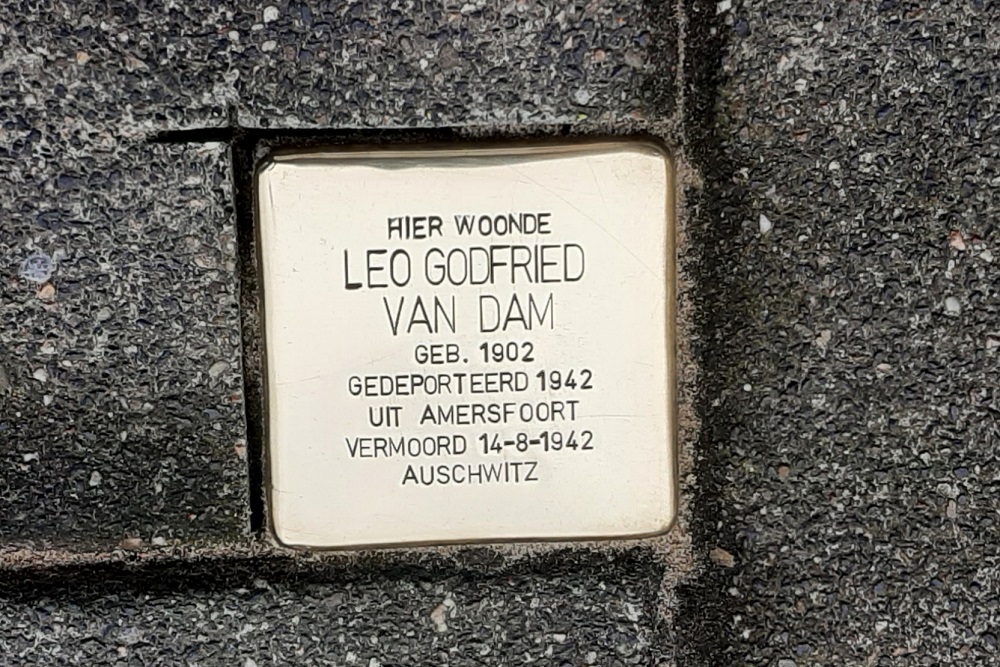Stumbling Stone Wilhelminastraat 49
STOLPERSTEIN / STUMBLING STONE
for:
Leo Godfried van Dam
The German artist Gunter Demnig started placing the first Stolpersteine in 1997 in the Berlin's Kreuzberg district.
Meanwhile there are Stolpersteine in many countries.
It reminds the Holocaust in World War II.
A Stolperstein is a concrete stone of 10 x 10cm, with a brass plate on top, in which the name, date of birth and decease and also place of decease is punched into.
The Stolperstein gets a place in the pavement in front of the former house of the victim.
By doing this, Gunter Demnig gives a private memorial to each victim.
His motto is: 'A HUMAN BEING IS FORGOTTEN ONLY WHEN HIS OR HER NAME IS FORGOTTEN'.
Borne was the first town in the Netherlands in which Stolpersteine were placed.
This happened the 29-11-2007.
Leo Godfrey van Dam
June 2, 1902 (Haarlem) – August 14, 1942 (Auschwitz)
Leo Godfried van Dam was born in 1902 as the second child in a politically and socially involved family. His father, André van Dam, was a general practitioner and his mother, Evelina Cohen, was active in the Free-thinking Democratic Association (VDB) in Haarlem. There were also two daughters, Engelina Henriette (22-1-1899) and Frieda Emma (8-10-1903), both of whom died very young.
The Van Dam family lived in Wilhelminastraat, which was renamed Schouwburgstraat by the Nazis during the war. After his father's death in 1929, Leo continued to live in the house, where he had been established since 1925 as an independent lawyer and attorney. On 4 June 1930 he married the non-Jewish Johanna (Jo) Drijver. Their marriage remained childless and was dissolved on February 11, 1943. According to a handwritten note by the clerk of the district court in Haarlem, this divorce was revoked on January 23, 1945.
From an early age, Leo van Dam was active in the Free-thinking Democratic Association (VDB) in Haarlem. He was co-founder of the youth organization of the VDB and chairman of the national Youth Peace Action. In the 1930s he was a very successful member of the Haarlem Municipal Council on behalf of the VDB. He was also a board member of various associations, including the Association for League of Nations and Peace, and he gave lectures on disarmament. In lectures and writings, Leo van Dam showed himself to be a fervent opponent of national socialism and the NSB, but he also spoke out against communism. In addition to his political involvement, he was a member of the Freemasons Lodge Kennemerland in Haarlem.
In the May days of 1940, Leo van Dam tried in vain to escape to England via IJmuiden. In 1941 he went into hiding, according to a former neighbor somewhere in North Amsterdam. Despite the fact that he had a mixed marriage, Leo was arrested very early, probably in the spring of 1942. There seems to be an active hunt for him. This was probably related to his reputation as a democratic politician and his open opposition to the NSB. After his arrest, Leo van Dam was transferred to the prison in Scheveningen (the Oranjehotel) and then on 8 July 1942 to Camp Amersfoort. From there he was deported to Auschwitz on 16 July 1942 via Westerbork. The wagons with prisoners from camp Amersfoort were coupled in Westerbork to the waiting train to Auschwitz. There he was murdered on or around August 14, 1942.
Deported from camp Amersfoort to Auschwitz on 16 July 1942
Murdered in Auschwitz on August 14, 1942
He turned 40 years old
Do you have more information about this location? Inform us!
Source
- Text: Reini Elkerbout
- Photos: Piet Sebregts
Nearby
Museum
Point of interest
- Office Heerbankwartier II WA - Haarlem
- Regional Quarter Nationale Jeugdstorm - Haarlem
- NSB Office Haarlem - Haarlem
Monument
- Stubling Stones Rollandslaan 21 - Haarlem
- Memorial Old Bavo School - Haarlem
- Memorial Mourning Woman - Haarlem
Cemetery
- Dutch War Graves General Cemetery Kleverlaan - Haarlem
- Commonwealth War Grave General Cemetery Kleverlaan - Haarlem
- Dutch War Graves Roman Catholic Cemetery St. Barbara - Haarlem
Remembrance Stone
- Stumbling Stones Wilhelminastraat 50 - Haarlem
- Stumbling Stone Oude Zijlvest 43 - Haarlem
- Stumbling Stone Oude Zijlvest 25 - Haarlem
Fortification
- FLAK Stand Haarlem - Haarlem
- Atlantikwall - Regelbau 610 - Bloemendaal
- Atlantikwall - Vf Beobachter - Bloemendaal





